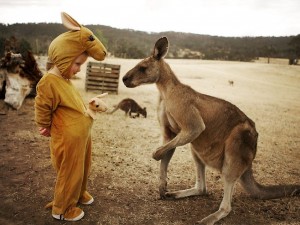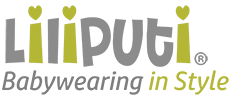A mom is waiting in line at the checkout, her 3 month old baby is sleeping in a front baby carrier. Just in front of them, there is another mom with a little girl, who is about three years old. The baby is tiny, only his hands and little legs stick out of the sling, his little head and body are both covered. The three-year-old is studying them quizzically, stepping away from her mother than going back again. She has huge blue eyes and curly, blond hair. Finally she steps to the mom with the baby, and asks:
„Is he born yet?”
 After a short pregnancy, kangaroo moms give birth to a tiny (less than half a gram!) newborn, who climbs into its mom’s pouch, only suckling and resting there for a couple of months. When the kangaroo baby grows strong enough, it pokes its little head out of the pouch, and soon sets off on its own to explore the world. But the kangaroo mother’s pouch provides protection and food for several more months. Although a human newborn is much more developed than a kangaroo baby, it seems premature compared to most baby mammals. It needs a mother to stay alive and reach the optimal mental and physical development; or some sort of caregiver who, being close physically, is able to attune to the needs of the little one, and ensures proper nutrition and safety.
After a short pregnancy, kangaroo moms give birth to a tiny (less than half a gram!) newborn, who climbs into its mom’s pouch, only suckling and resting there for a couple of months. When the kangaroo baby grows strong enough, it pokes its little head out of the pouch, and soon sets off on its own to explore the world. But the kangaroo mother’s pouch provides protection and food for several more months. Although a human newborn is much more developed than a kangaroo baby, it seems premature compared to most baby mammals. It needs a mother to stay alive and reach the optimal mental and physical development; or some sort of caregiver who, being close physically, is able to attune to the needs of the little one, and ensures proper nutrition and safety.
Are human babies hampered in motor skills, independence skills, social development and discovering the world, if they spend most of their first years in a carrier?
“The carried baby’s motor skills development is not delayed due to babywearing,” says Judit Sződy, psychologist, lactation consultant, journalist, doula, mother of four. “There are two points to clarify here. One is that motor skills development is related to maturing rather than practice. In some cultures, babies are tucked in tight into a cradle or swaddle, and are taken out only for ‘child-care tasks’. The day of liberation is only due in the second half a year. These babies are not significantly lagging behind in movements compared to their crawling peers. They only need one or two weeks to catch up.”
“Another important information is that babywearing does not mean that the little one is passive. Carried babies’ muscles are active while being in a carrier. They follow the parent’s movements, and although only slightly, but react to off-balance, hold their head, when their mother bends – given they are not asleep. Therefore, they are active, too. And we haven’t talked about the plethora of stimuli that affects their vestibular system. The balance system located in the inner ear is constantly stimulated, which greatly contributes to the development of the brain and the evolving of connections between different brain regions.”
Carried babies develop in the most natural way
They live through the „reality” of every-days from household chores through sensations in the street to social events. They gain their own experiences, and are able to process impressions according to their maturity and interests.
“Carried babies are exposed to a sea of information, which they can hide from, if they do not happen to like it. They have a control over how much they would like to take part in the happenings around them, thus they cannot really be overstimulated. If they have had enough, they huddle close to their mom or they simply fall asleep. When carried, babies see the world from the carrier’s point of view, so they gather entirely different experiences from kids playing on the ground or sitting in a pram. Meanwhile, low stress level necessary for processing information is always ensured to them. It has long been known that you can learn the most efficiently, when you feel good and safe.”
Children who are regarded equal by their parents and siblings will become an active member of their environment easily and smoothly, acquiring all forms of communication abilities.
“Socialization is a lifelong process, since one continually has to adapt to the social environment. Naturally, the first month of our lives have a huge impact on us,” Judit Sződy says. “If babies start socializing wrapped in the parent’s safe closeness, they are not worse off at all compared to babies who are not carried. As long as parents go out or accept visitors, of course. If carried babies want to make friends, or play with other children, they will show that they wish to leave the sling. They are able to do this just the way they indicate that they would like to be fed. We can rely on their signals.”
We often make the mistake of expecting too much from our children, because we would like to live up to certain norms – usually pressed by our environment.
Independence in the first period is not up to the parent, either – just as we saw in case of the development of vital movements. As soon as babies are mature enough, they acquire certain skills and they indicate that they would like to put them to the touch. Carried babies will also arrive at the stage, when they want to do everything on their own. That will be the real independence. Unfortunately, the idea is knocking round that an independent baby is able to fall asleep alone, play alone and calm down alone. According to research, babies who behave this way are not at all independent. Rather, they have learnt that it is not worth to call their parents. But their stress hormone level is just the same as babies’ who cry to call their caregiver. On the other hand, carried babies, who are breastfed on demand, dare to cry and express that they do not want to sleep alone at night, and be alone during the day. It is an innate, pristine claim, since in ancient time, babies left on their own could be in danger. Babies do not know which century they are born into, it takes several months for them to learn that they shouldn’t be afraid to play Lego in their room, no saber-toothed tiger will come.
It requires time, and a lot of patience on the parent’s part.
Okay, humans aren’t marsupials after all, but they are definitely carrier species.
… first, babies stick their little head out of the embrace of the sling, then they take their first steps (although crawling) curious of everything – smells, tastes, colours and textures.
They slowly let our hands go, run, ask questions and give opinions. And when they need peace and silence, they return into our lap, the warmth of our body and soul.


1 comment
add commentThank you Judit for this article! Oh, and I love that Coat!!! Need to get one
Leave Comment
You must be logged in to post a comment.